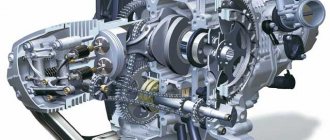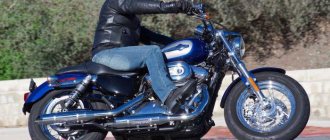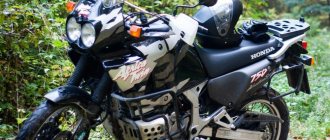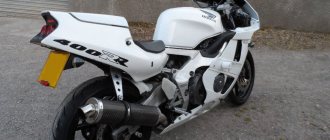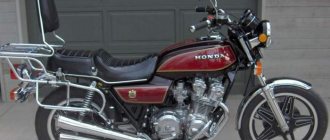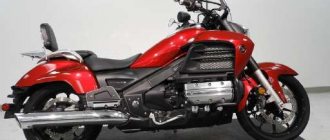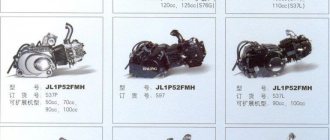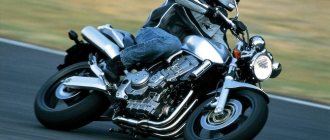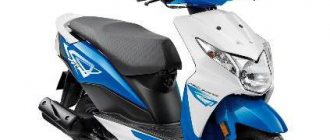VFR 1200F
- Honda motorcycle model
The Honda VFR1200F sports tourer model was first presented as a concept in 2008 at the Intermot exhibition in Cologne. Production of the model started at the end of 2009, and official deliveries of motorcycles began in 2010. The Honda VFR1200F positioned itself as the “big brother” of the Honda VFR800F and as the flagship model of the VFR line.
The basis of the Honda VFR1200F was a specially developed 4-cylinder V-twin liquid-cooled engine with a volume of 1237 cm³ and producing 173 hp. power and 129 Nm of torque. The layout of the engine is such that the cylinder camber angle is not 90°, but 76°. In addition, the pairs of cylinders are not strictly opposite each other, but are spaced apart. Also, due to changes in the crankshaft angle and the sequence of flashes in the cylinders, the engine is practically vibration-free, and at the same time does not have a balance shaft. The timing system is driven by a chain, and the valves are controlled by rocker arms, which made it possible to use only one camshaft in each cylinder head.
In addition to the main version of the motorcycle, a modification with an automatic transmission (DCT - dual clutch transmission) was also presented, which was designated Honda VFR1200FD (in the North American market - Honda VFR1200FA).
Other features of the motorcycle include an aluminum frame, adjustable suspension, a cantilever rear swingarm (a signature feature of almost all VFR series motorcycles), powerful combined 6-piston radial brakes with ABS, an 18.5-liter fuel tank, a cardan drive and 268 kg of curb weight. weight (on version with manual transmission).
In 2012, the Honda VFR1200F model underwent minor changes, receiving a traction control system (TCS - traction control system), different camshafts (Japanese versions), as well as settings for the control unit (ECU) and automatic transmission (DCT). The fuel tank capacity has been increased from 18.5 to 19.0 liters.
The 2016 and 2021 Honda VFR1200F models are currently on sale in the market. the model was not produced.
Based on the Honda VFR1200F, a dual-sport model was built in 2012 - the Honda VFR1200X Crosstourer.
Brief history of the model
2010 - start of production and sales. Model: Honda VFR1200F; Honda VFR1200FD (DCT) (all regions). Factory designation: VFR1200FA, VFR1200FDA.
2011 - no significant changes. Model: Honda VFR1200F; Honda VFR1200FD (DCT) (all regions). Factory designation: VFR1200FB, VFR1200FDB.
2012 - the model receives new camshafts (Japanese modifications), traction control system (TCS), new settings for the injector and automatic transmission. Fuel tank capacity increases from 18.5 to 19.0 liters. Model: Honda VFR1200F; Honda VFR1200FD (DCT) (all regions). Factory designation: VFR1200FC, VFR1200FDC.
2013 - no significant changes. Model: Honda VFR1200F; Honda VFR1200FD (DCT) (all regions). Factory designation: VFR1200FD, VFR1200FDD.
2014 - no significant changes. Model: Honda VFR1200F; Honda VFR1200FD (DCT) (all regions). Factory designation: VFR1200FE, VFR1200FDE.
2015 - no significant changes. Model: Honda VFR1200F; Honda VFR1200FD (DCT) (all regions). Factory designation: VFR1200FF, VFR1200FDF.
2016 - no significant changes. Model: Honda VFR1200F; Honda VFR1200FD (DCT) (all regions). Factory designation: VFR1200FG, VFR1200FDG.
Specifications
| Model | Honda VFR1200F |
| Motorcycle type | sports tourist |
| Year of issue | 2010-2016 |
| Frame | aluminum |
| engine's type | 4-cylinder, 4-stroke, V-shaped (76°) |
| Working volume | 1237 cm³ |
| Bore/Stroke | 81.0 x 60.0 mm |
| Compression ratio | 12.0:1 |
| Cooling | liquid |
| Number of valves per cylinder | SOHC, 4 valves per cylinder |
| Fuel supply system | injector, PGM-Fi, 44 mm |
| Ignition type | transistor |
| Maximum power | 173.0 hp (127.0 kW) at 10,000 rpm 111.0 hp (82.0 kW) at 8500 rpm (domestic Japanese versions VFR1200F/FD 2010-2011) 111.0 hp (82.0 kW) at 7500 rpm (domestic Japanese versions VFR1200F/FD 2012+) + TCS (traction control system) – VFR1200F/FD (2012+) |
| Maximum torque | 129 Nm (13.0 kg*m) at 8750 rpm 111 Nm (11.3 kg*m) at 6000 rpm (domestic Japanese versions VFR1200F/FD 2010-2011) 120 Nm (12.2 kg*m) at 5500 rpm (domestic Japanese versions VFR1200F/FD 2012+) + TCS (traction control system) – VFR1200F/FD (2012+) |
| Transmission | 6-speed - VFR1200F 6-speed automatic (DCT) - VFR1200FD |
| type of drive | cardan |
| Front tire size | 120/70ZR17 M/C (58W) |
| Rear tire size | 190/55ZR17 M/C (75W) |
| Front brakes | 2 discs, 320 mm, 6-piston radial calipers (C-ABS) |
| Rear brakes | 1 disc, 276 mm, 2-piston caliper (C-ABS) |
| Front suspension | 43 mm telescopic inverted fork (adjustable preload and rebound), travel - 108 mm |
| Rear suspension | pendulum Pro-Link with monoshock absorber (adjustable preload and rebound), stroke - 130 mm |
| Motorcycle length | 2250 mm |
| Motorcycle width | 755 mm – VFR1200F 740 mm – VFR1200FD (DCT) |
| Motorcycle height | 1220 mm |
| Wheelbase | 1545 mm |
| Seat height | 810 mm 790 mm – VFR1200F/FD (domestic Japanese versions) |
| Minimum ground clearance (clearance) | 125 mm |
| Acceleration to 100 km/h | 3.0 sec |
| Maximum speed | 250 km/h |
| Gas tank capacity | 18.5 l – VFR1200F/FD (2010-2011) 19.0 l – VFR1200F/FD (2012+) |
| Motorcycle weight (curb) | 268 kg – VFR1200F 278 kg – VFR1200FD (DCT) |
Honda VFR1200F Review
“This is one of the most exciting motorcycles in Honda history,” said Powersports Press manager Bill Savino. “The VFR1200F completely redefined motorcycle performance by taking the rich heritage of the V-4 VFR and extending it into the future of Honda motorcycles. The new technologies incorporated into this bike are absolutely stunning and work together to put the VFR1200F ahead of the curve in demonstrating what a high-quality machine should look, perform and feel like. This is a sports bike that will leave a smile on your face and that can do more even after you've been on it for hours."
VFR1200F
The 2010 VFR1200F introduces a new generation of technology, delivering unparalleled benefits for those riders who want a sports bike that completely breaks traditional boundaries. Honda's V-4 heritage has been completely reimagined in a wonderfully innovative way by fusing modern technologies to produce futuristic sports motorcycles designed for pure riding pleasure, built for experienced hands, for those who ride hard, long, far and often.
Just a small sampling of the incredible features and innovations found in the VFR1200F include:
- Honda MotoGP engine technology and architecture, which offers a lightweight and compact liquid-cooled V-4 engine with a displacement of 1237 cc, developing amazing levels of power;
— Throttle By Wire technology to provide a new generation of throttle response;
- lightweight and compact Unicam® valve train, allowing the use of significantly smaller cylinder heads;
— optional Dual Clutch Automatic transmission with manual shifting, two automatic modes D and S, and a paddle-type shift mechanism;
— clutch release fork in manual gear shifting VFR1200F;
- Multi-layer fairing technology for unrivaled airflow control and a futuristic look;
- A new generation driveline system with an offset center of rotation and a constant speed sliding joint to take driveline efficiency and controllability to a new level.
Features and Benefits
Building on the long tradition of innovation in the Honda V-4 family of motorcycles, the 2010 VFR1200F incorporates a new generation of V-4 engine technology and unrivaled rider benefits, setting the stage for Honda's product development for the next 50 years. The V-4 heritage and VFR heritage are fully realized in the VFR1200F. It has been re-created in a wonderfully innovative form by merging modern MotoGP technology and other modern approaches. The result is a futuristic sports bike designed for pure riding pleasure, aimed at experienced hands, and designed for those who ride hard, long, far and often.
Characteristics
- Honda's MotoGP technology for the V-4 engines and overall architecture ensured the VFR1200F's state-of-the-art performance characteristics.
- The unique cylinder placement, with the rear two cylinders located on the inside of the crankshaft and the front cylinders on the outside, narrows the rider's seating area on the VFR1200F.
- Throttle By Wire technology creates a new sensation of throttle response
- The optional Dual Clutch Automatic transmission features manual shift mode, two automatic modes, D and S, and paddle shift, offering unparalleled freedom.
- The new generation driveline system, with an offset center of rotation and a constant speed sliding joint, takes driveline efficiency and controllability to a new level.
- One-year, transferable warranty, unlimited mileage limited warranty, extended warranty available through the Honda Protection Plan.
Engine/Transmission
- The lightweight and compact 1237 cc, liquid-cooled, 76-degree V-4 engine delivers amazing levels of power for a unique feel and sound.
- The symmetrical clutch timing crankshaft uses a 28-degree crank pin offset to eliminate fundamental engine vibration.
- The asymmetrical exhaust length between the front and rear cylinders dramatically increases power output and enhances the feeling of power.
- The lightweight and compact Unicam® valve train allows the use of significantly smaller cylinder heads.
- The Honda clutch release fork ensures an effortless sporty ride when manually shifting gears.
Chassis/Suspension
- GP technology for the multi-layer fairing provides excellent airflow control.
- The Honda Pro Arm® single-sided swing arm with gas shock is a staple of modern rear suspension performance. It features convenient remote spring preload adjustment, rebound damping adjustment, and provides 5.1 inches (130 mm) of rear wheel travel.
- Durable, sport-rated reverse fork with 43mm tubes, adjustable spring preload and 4.7 inches (120mm) of front wheel travel.
- New controls provide more precise and smooth tactile sensations, enhancing the driver experience.
- The new seat design technology offers a higher level of seat shape and its components.
- A seat bag is fitted as standard on both versions of the VFR1200F.
History of development
Honda's long tradition of producing trend-setting cars has been marked by one star after another, enough to fill the entire sky. Among these stars, however, stand out the best and brightest of the Honda clan: the VFR series of motorcycles. Right after its debut in 1983, the VF750F Interceptor featured more than enough flashy new technology to rewrite the rules for the entire sportbike class, and its performance characteristics immediately made it a hit among motorcycle enthusiasts and the press alike.
The state-of-the-art liquid-cooled V-4 engine, square-section frame, and race-generation chassis—stunning innovations for its time—literally revolutionized the state of the art in power and handling. Over the next decades, these steps, and those that followed, gave the VFR an impressive mandate, leading to countless achievements, including victories in the AMA and World Superbike championships, as well as trophies for the best motorcycle in its class, and its annual inclusion in the lists of the best ten by the enthusiastic press. . It should come as no surprise that the VFR family, through its many incarnations, has established itself as one of the most beloved motorcycles to hit the pavement.
During its service life, which spanned more than a quarter of a century, the VFR family brought new technologies to market as they were developed. In fact, VFR development advanced so far in the 1990s that Honda split its V-4 family into two. The race-focused RC30 and RC45 feature the latest concepts and performance options to continue achieving even greater glory on tracks around the world. And the VFR/Interceptor has evolved into a street sportbike for those who are drawn to the challenge of the road and who are excited by the opportunity to get the most out of a motorcycle, whether it's short distances or long trips.
Now that legacy of innovation in the Honda V-4 family carries over to the next generation of new technology and uncompromising rider benefits with the 2010 VFR1200F. In this bike we can easily recognize the heritage of Honda V-4 and VFR tradition, which has been recreated in an incredibly original fusion of modern concepts of the MotoGP world with other modern solutions. And the result of this merger was
a sports bike designed for pure riding pleasure, designed specifically for experienced hands, for those who ride hard, long, far and often.
Improved technology
- Honda MotoGP Engine Technology and Architecture
- Lightweight and compact 1237 cc liquid cooled V-4 engine with 76 degree cylinder angle
- Unique cylinder placement with the rear two cylinders located on the inside of the crankshaft and the front cylinders on the outside
- Symmetrical clutch timing crankshaft uses 28 degrees of crank pin offset to eliminate fundamental engine vibration
- Asymmetrical exhaust length between front and rear cylinders
- Throttle By Wire Technology
- Lightweight and compact Unicam® valve train
- Continuous oil pressure monitoring
- The optional dual-clutch transmission has manual and automatic modes, with D and S modes and paddle shift.
- Honda clutch release fork to facilitate manual gear shifting
- GP technology multi-layer air fairing
- Honda Pro Arm® Single-Side Swing Arm with Single Shock
- New generation driveline system with offset center of rotation and constant speed sliding joint
- New controls for a more precise and smooth feel
- New seat design technology.
Engine
The VFR1200F is powered by a lightweight, compact 1237cc liquid-cooled V-4 engine with a 76-degree cylinder angle. This is a direct result of the development of V-4 RC212V MotoGP technology. Mass centering plays a key role in this design, resulting in the VFR1200F's unique cylinder placement. Its two rear cylinders are located in the center of the crankshaft, while the front cylinders are placed on the sides. This configuration significantly narrows the rear cylinder head block, and with it the entire rear section of the engine, affecting the rider's seating area. Because the engine is unusually narrow, especially around the rear cylinders—and overall more compact than the Interceptor's 781cc engine—the rider's seating area on this 1,237cc machine has a noticeably narrower profile. This distinct wasp-waist ergonomics allows the rider to sit low “inside” the motorcycle rather than feeling perched on top of the machine. And as an added benefit, this gives you a shorter distance to the ground when you have to stop the bike.
The VFR1200F engine is also combined with a high-strength, symmetrical clutch-phase crankshaft whose 28-degree crank pin offset is perfectly matched to the 76-degree V-twin angle of the cylinders, significantly reducing underlying engine vibration for a smooth ride. And since the motorcycle's power center is now perfectly balanced, the need for a balance shaft is eliminated. This makes the engine more compact and also saves nearly 3 pounds (1.3 kg) in weight. To accentuate the V-4 feel of the VFR1200F, the unique firing sequence between cylinders (104 - 256 - 104 - 256 degrees) further accentuates the VFR's firing rhythm. Another design element that enhances the VFR1200F's feel can be found in the exhaust system. It should be noted that the main pipes of the two front cylinders are significantly longer than the main pipes of the rear cylinders, which is a first for Honda. This difference in pipe lengths changes the exhaust pulse tuning, creating a unique power delivery that's a thrilling blend of V-4 thrust and aggressive down-the-line punch. And make no mistake: the VFR1200F delivers Honda's famous V-4 power in spades, as more than 90% of the engine's peak torque occurs at 4,000 rpm, giving the car excellent initial acceleration in any gear.
A big part of the VFR1200F's compact engine size and monster power output is the Unicam valvetrain, a Honda-exclusive system that debuted on the championship-winning motocross CRF450R. A single overhead camshaft directly controls the two intake valves in each cylinder, while an integrated variable roller balancer arm controls the two exhaust valves in each cylinder. Unicam technology reduces weight and footprint compared to a dual camshaft design, while delivering a five-digit 10,200 rpm rev limit. As a further advantage, the Unicam system allows the use of a very flat combustion chamber, resulting in faster and more efficient fuel combustion.
Another concept taken from MotoGP design and first introduced to the public with Honda's CRF® family of motocross motorcycles is the use of a sealed crankcase system that maintains a slight negative pressure to minimize mechanical loss or "air drag." This system takes advantage of the dry sump design (reducing oil mixing losses) without the need for a separate oil container. The cleaning pump pumps oil and gases out of the crank chamber, and this decrease in atmospheric pressure reduces the resistance to movement of the engine's reciprocating components - the crankshaft, pistons and connecting rods. The result is additional power, improved throttle response and improved fuel efficiency. The VFR1200F also includes a new, more sophisticated constant oil pressure monitoring system that can read oil pressure fluctuations within the safe operating area, rather than just reporting the presence of minimum or no oil pressure.
The new VFR1200F uses, among other things, another innovation from Honda: the Throttle By Wire (TBW) system. Given the arrangement of the throttle valves in Programmed Fuel Injection (PGM-FI), the limitations imposed by the mechanically coupled and controlled throttle-stick system have been eliminated. As a result, the VFR1200F's throttle servo (TBW) is much smaller and lighter than a traditional cable-based system. In addition, the servo is involved in the Electrical Control Unit (ECU), which processes information from the throttle control, engine speed information from the crankshaft position sensor, pressure information, gear position, motorcycle speed, coolant temperature and incoming air temperature. Throttle position allows the TBW system to transmit more precise throttle response to the handlebar for greater driver perception than mechanically coupled systems. At the same time, it provides more accurate and smooth fuel delivery than would be possible without this system.
The ultimate benefit for the rider is an unprecedented level of control and throttle feel. This is truly a new generation level, a level of more direct connection with the machine, enhancing the sensations of the motorcyclist. Additionally, the VFR1200F's TBW system eliminates the need for a pneumatic distributor found in other Honda PGM-FI systems to provide stable idle performance. TBW simply delivers fuel more accurately than mechanically coupled PGM-F1 systems, regardless of driving conditions. From a rider's perspective, TBW's work to improve engine response and performance is invisible, although it does create a more linear and well-connected throttle feel and improves fuel economy.
To qualify as a super-sophisticated sports car, the VFR1200F must have a standard six-speed manual transmission. It can also be optionally equipped with an exciting new look in motorcycle technology, Honda's Dual Clutch transmission, the world's first fully automatic dual-clutch transmission for large-displacement sports motorcycles. This new transmission gives riders all the power of sporty riding with the effortless, smooth performance of a motorcycle while delivering fuel economy comparable to a traditional manual transmission. To meet the needs of motorcyclists in a wide variety of conditions and situations, the new transmission has three operating modes: two fully automatic modes (D mode for normal riding situations and S mode for sport riding), as well as a manual mode of six speeds for full control. The latter mode is implemented via a shift key, creating the same feeling of shifting gears as a manual gearbox. Please refer to the technical data sheet supplied with your motorcycle for this innovative transmission for further details.
To match the motorcycle's serious sporting capabilities, the VFR1200F's traditional manual transmission is equipped with a slipper clutch mechanism. This system operates like other Honda sliding clutches. It reduces the torque applied to the rear wheel as the engine speed drops (called "reverse torque") when the motorcycle enters a sharp turn while applying engine braking. As a result, engine braking slows the motorcycle without causing rear wheel vibration. This is an elegant and simple way to take advantage of the sliding clutch with minimal added weight and design complexity.
Along with the outstanding sporting qualities of the VFR1200F, it also has additional high-tech features that create an exciting riding experience for the rider. For example, the VFR1200F has four dampers on the engine and transmission to provide smooth power delivery. These are the clutch damper, output damper, cam damper and tornado damper, all of which work together to provide smooth power delivery without the loss felt between the throttle and the engagement field.
Chassis
The VFR1200F chassis is based on a diamond-shaped frame with four aluminum cross members. The frame is both lightweight and durable. The length of the swing arm and the height of the driveshaft are optimized without increasing the overall length of the motorcycle, but use a clever and elegant solution: the output shaft is located under the transmission countershaft, increasing the compactness of the engine, and allowing the use of a longer rocker arm without increasing the overall wheelbase. This solution increases handling and traction while remaining within the dimensions of a modest 60.8 inches (1544 mm) wheelbase. The prominent Pro-Arm single-sided swing arm sits in a wide swing area within the frame, increasing chassis rigidity, and the swing arm support rod is positioned higher than the drive shaft. This highly engineered driveline system features a driveshaft running under the sway bar, allowing for wider spacing between the sway bar and frame for increased strength and rigidity. The sliding constant velocity (CV) joint compensates for variations in driveshaft length through the arc of the rear wheel. Thanks to this new configuration and the rigidity of the support rod design, the new driveline system increases turning ability, high-speed handling, and traction compared to the previous generation driveline.
The Pro-Arm® single-sided swing arm system uses a single Pro-Link® gas shock absorber that includes a convenient, easy-to-adjust spring preload adjuster. In addition, the shock absorber has rebound damping adjustment. It gives 5.1 inches (130 mm) of wheel travel, while the 43 mm reverse front fork provides 4.7 inches (120 mm) of wheel travel, and also provides spring preload adjustment. Together, this combination of suspension adjustments at both ends of the bike allows the VFR1200F to be used in quite a variety of ways, whether for sporting events, casual long rides, or two-up adventures.
The VFR1200F also features sophisticated braking technology to complement its sporting capabilities. Powerful six-piston front brake calipers work with large 320mm floating discs, while the dual-piston rear caliper uses a 276mm disc. Honda's Combined Braking System (CBS) creates an optimal balance of front and rear braking force. With this CBS, pressing the front brake lever activates all the pistons in the caliper on the right side, and four pistons on the left side. The other two pistons on the left will be activated when the rear brake pedal is pressed. However, to maintain equal braking force when applying the front brake, these right-hand caliper pistons are 25mm in diameter, while the left-hand caliper pistons are 26mm and 30mm in diameter. These asymmetrical load-balanced brake pistons are another example of the thoughtfulness that sets the VFR1200F apart. In addition, the addition of a compact and lightweight ABS system also supports the motorcycle's exceptional performance in sporty riding and long-distance touring.
The balance of positive and negative body surfaces gives the VFR1200F a lightweight, open look while creating a profile that cuts through the air with the least amount of drag possible. Along with this modern, contemporary look comes a number of advantages. A closer look reveals that Honda's designers and engineers have worked together to ensure that this uniquely attractive shape also creates optimal airflow for maximum heat dissipation. The fairing design uses two layers that utilize airflow to achieve certain dynamic benefits. Air flowing between the layers and through two oval vents at the front of the fairing is redirected to enhance the bike's handling at high speeds and to help cool the engine. In addition, the air flow is deflected towards the rider's legs, keeping the rider cool and increasing ride comfort.
Engine cooling is optimized by actually increasing the speed of air flow before it reaches the radiators. This is done by directing air through conical holes. Additional holes on the sides of the housing direct air flow downward to cool the engine. And hot air from the engine is directed away from the rider to increase comfort. Additional air ducts and shielding technology remove heat from the rider's surroundings, increasing rider and passenger comfort.
For decades, Honda products have stood out from the crowd with a decidedly high level of fit and finish, but the 2010 VFR1200F raises the bar on quality control higher than ever. Great attention to detail and quality is evident throughout, but special attention must be paid to where the front fairing and body join together to create a smooth, unified aerodynamic surface. This incredibly tight and precise fit is made possible by a new generation of rectangular fasteners that hold the body panels in two dimensions much more securely than traditional fasteners can. And of course the use of the latest manufacturing technology at the new Kumamoto plant in Japan, where the VFR1200F is assembled, has contributed to the exceptional quality of fit and finish. This is an example of classic Honda attention to detail, but even more updated and improved.
Another thing worth noting is how Honda's new technologies work in the seat as well. This is where you can see the shape-forming parts that are different from those previously used, because of a new process that literally binds the seat covering (which has a special, soft-touch surface) to its padding. The result is precise shape control in every part of the seat, improving both ergonomics and the ability to make complex shapes.
Great attention to detail has been paid to the key components of the VFR1200F that the rider's fingers interact with. New and improved controls have been used here. This is where Honda engineers developed new switches and controls for the VFR1200F that return a smoother, more precise feel when used. Tactile feedback feels more immediate than ever before. From the smallest details to the grandest applications of racing technology, the 201 VFR1200F is full of innovation and innovation. This is a machine that has again changed the level of development of the industry. However, in each case, the target of all these changes remained the motorcycle driver. The VFR1200F offers enthusiasts a unique blend of elegant sophistication and rugged sporting performance that has never been offered to the general public before. This unique and lofty mission serves as the perfect goal for the 2010 V-4 VFR1200F, a machine that maintains its deep and rich V-4 heritage by creating a true revolution in sportbike design, and which consistently manages to emulate the history of its illustrious predecessors in changing the sport. .
VFR1200F Specifications | |
| Model: | VFR1200F/VFR1200F with dual clutch automatic transmission |
| Engine's type: | 1237 cm3, liquid cooled, 76° V-4 |
| Cylinder diameter and piston stroke: | 81 mm x 60 mm |
| Compression Ratio: | 12.0:1 |
| Valve mechanism: | SOHC: four valves per cylinder |
| Suction: | PGM-FI with auto enrichment, 44mm throttle bodies, 12 hole injectors |
| Ignition: | Digital transistor with electronic advancement |
| Transmission: | Six speed (VFR1200F) or six-speed with two automatic modes and manual mode (VFR1200F) |
| Main gear: | Cardan shaft |
| Front suspension: | 43mm fork with damper cartridge and adjustable spring preload. Wheel travel 4.7 inches (130 mm) |
| Rear suspension: | Pro Arm single-sided swing arm with Pro-Link® gas shock with remote spring preload adjustment and rebound damping adjustment. Wheel travel 5.1 inches (130 mm) |
| Front brakes: | Twin 320mm floating discs with CBS, six piston calipers and ABS |
| Rear brakes: | Single 276mm disc with CBS, six piston calipers and ABS |
| Front wheel: | Radial 120/70 ZR17 |
| Rear wheel: | Radial 190/55 ZR17 |
| Wheelbase: | 60.8 inches (1545 mm) |
| Steering wheel tilt (tilt angle) | 25°30’ |
| Track: | 101.0 mm (4.0 in) |
| Seat height: | 32.1 inches (815 mm) |
| Fuel tank capacity: | 4.9 gal (18.5 l) |
| Color: | Red |
| Own weight:* | 591 lb (268 kg) (VFR1200F) / 612 lb (278 kg) (VFR1200F with dual-clutch automatic) |
| * Includes all standard equipment, required fluids, and a full tank of fuel - ready to ride. | |
